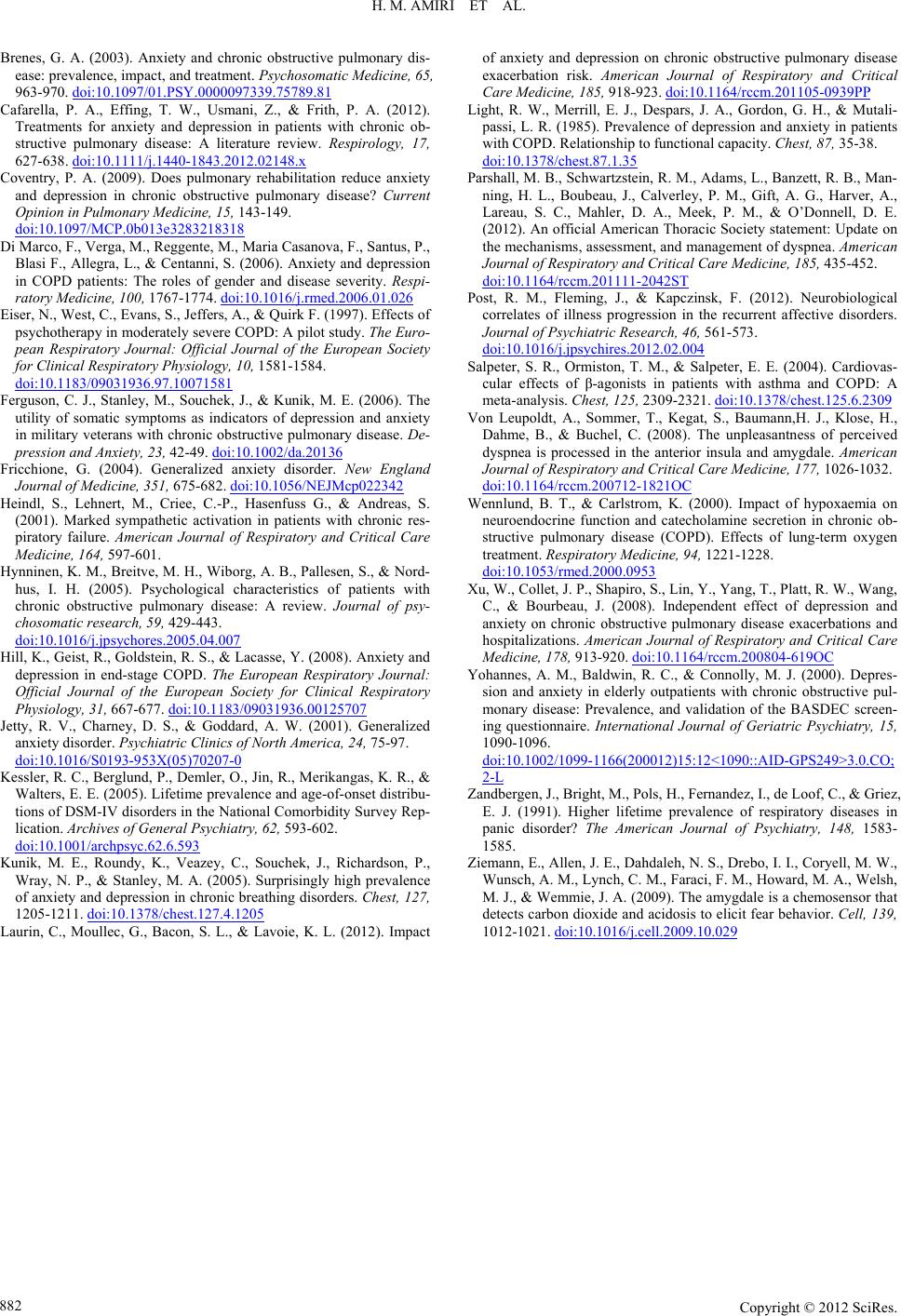
H. M. AMIRI ET AL.
Copyright © 2012 SciRes.
882
Brenes, G. A. (2003). Anxiety and chronic obstructive pulmonary dis-
ease: prevalence, impact, and treatment. Psychosomatic Medicine, 65,
963-970. doi:10.1097/01.PSY.0000097339.75789.81
Cafarella, P. A., Effing, T. W., Usmani, Z., & Frith, P. A. (2012).
Treatments for anxiety and depression in patients with chronic ob-
structive pulmonary disease: A literature review. Respirology, 17,
627-638. doi:10.1111/j.1440-1843.2012.02148.x
Coventry, P. A. (2009). Does pulmonary rehabilitation reduce anxiety
and depression in chronic obstructive pulmonary disease? Current
Opinion in Pulmonary Medicine, 15, 143-149.
doi:10.1097/MCP.0b013e3283218318
Di Marco, F., Verga, M., Reggente, M., Maria Casanova, F., Santus, P.,
Blasi F., Allegra, L., & Centanni, S. (2006). Anxiety and depression
in COPD patients: The roles of gender and disease severity. Respi-
ratory Medicine, 100, 1767-1774. doi:10.1016/j.rmed.2006.01.026
Eiser, N., West, C., Evans, S., Jeffers, A., & Quirk F. (1997). Effects of
psychotherapy in moderately severe COPD: A pilot study. The Euro-
pean Respiratory Journal: Official Journal of the European Society
for Clinical Respiratory Physiology, 10, 1581-1584.
doi:10.1183/09031936.97.10071581
Ferguson, C. J., Stanley, M., Souchek, J., & Kunik, M. E. (2006). The
utility of somatic symptoms as indicators of depression and anxiety
in military veterans with chronic obstructive pulmonary disease. De-
pression and Anxiety, 23, 42-49. doi:10.1002/da.20136
Fricchione, G. (2004). Generalized anxiety disorder. New England
Journal of Medicine, 351, 675-682. doi:10.1056/NEJMcp022342
Heindl, S., Lehnert, M., Criee, C.-P., Hasenfuss G., & Andreas, S.
(2001). Marked sympathetic activation in patients with chronic res-
piratory failure. American Journal of Respiratory and Critical Care
Medicine, 164, 597-601.
Hynninen, K. M., Breitve, M. H., Wiborg, A. B., Pallesen, S., & Nord-
hus, I. H. (2005). Psychological characteristics of patients with
chronic obstructive pulmonary disease: A review. Journal of psy-
chosomatic research, 59, 429-443.
doi:10.1016/j.jpsychores.2005.04.007
Hill, K., Geist, R., Goldstein, R. S., & Lacasse, Y. (2008). Anxiety and
depression in end-stage COPD. The European Respiratory Journal:
Official Journal of the European Society for Clinical Respiratory
Physiology, 31, 667-677. doi:10.1183/09031936.00125707
Jetty, R. V., Charney, D. S., & Goddard, A. W. (2001). Generalized
anxiety disorder. Psychiatric Clinics of North America, 24, 75-97.
doi:10.1016/S0193-953X(05)70207-0
Kessler, R. C., Berglund, P., Demler, O., Jin, R., Merikangas, K. R., &
Walters, E. E. (2005). Lifetime prevalence and age-of-onset distribu-
tions of DSM-IV disorders in the National Comorbidity Survey Rep-
lication. Archives of General Psychiatry, 62, 593-602.
doi:10.1001/archpsyc.62.6.593
Kunik, M. E., Roundy, K., Veazey, C., Souchek, J., Richardson, P.,
Wray, N. P., & Stanley, M. A. (2005). Surprisingly high prevalence
of anxiety and depression in chronic breathing disorders. Chest, 127,
1205-1211. doi:10.1378/chest.127.4.1205
Laurin, C., Moullec, G., Bacon, S. L., & Lavoie, K. L. (2012). Impact
of anxiety and depression on chronic obstructive pulmonary disease
exacerbation risk. American Journal of Respiratory and Critical
Care Medicine, 185, 918-923. doi:10.1164/rccm.201105-0939PP
Light, R. W., Merrill, E. J., Despars, J. A., Gordon, G. H., & Mutali-
passi, L. R. (1985). Prevalence of depression and anxiety in patients
with COPD. Relationship to functional capacity. Chest, 87, 35-38.
doi:10.1378/chest.87.1.35
Parshall, M. B., Schwartzstein, R. M., Adams, L., Banzett, R. B., Man-
ning, H. L., Boubeau, J., Calverley, P. M., Gift, A. G., Harver, A.,
Lareau, S. C., Mahler, D. A., Meek, P. M., & O’Donnell, D. E.
(2012). An official American Thoracic Society statement: Update on
the mechanisms, assessment, and management of dyspnea. American
Journal of Respiratory and Critical Care Medicine, 185, 435-452.
doi:10.1164/rccm.201111-2042ST
Post, R. M., Fleming, J., & Kapczinsk, F. (2012). Neurobiological
correlates of illness progression in the recurrent affective disorders.
Journal of Psychiatric Research, 46, 561-573.
doi:10.1016/j.jpsychires.2012.02.004
Salpeter, S. R., Ormiston, T. M., & Salpeter, E. E. (2004). Cardiovas-
cular effects of β-agonists in patients with asthma and COPD: A
meta-analysis. Chest, 125, 2309-2321. doi:10.1378/chest.125.6.2309
Von Leupoldt, A., Sommer, T., Kegat, S., Baumann,H. J., Klose, H.,
Dahme, B., & Buchel, C. (2008). The unpleasantness of perceived
dyspnea is processed in the anterior insula and amygdale. American
Journal of Respiratory and Critical Care Medicine, 177, 1026-1032.
doi:10.1164/rccm.200712-1821OC
Wennlund, B. T., & Carlstrom, K. (2000). Impact of hypoxaemia on
neuroendocrine function and catecholamine secretion in chronic ob-
structive pulmonary disease (COPD). Effects of lung-term oxygen
treatment. Respiratory Medicine, 94, 1221-1228.
doi:10.1053/rmed.2000.0953
Xu, W., Collet, J. P., Shapiro, S., Lin, Y., Yang, T., Platt, R. W., Wang,
C., & Bourbeau, J. (2008). Independent effect of depression and
anxiety on chronic obstructive pulmonary disease exacerbations and
hospitalizations. American Journal of Respiratory and Critical Care
Medicine, 178, 913-920. doi:10.1164/rccm.200804-619OC
Yohannes, A. M., Baldwin, R. C., & Connolly, M. J. (2000). Depres-
sion and anxiety in elderly outpatients with chronic obstructive pul-
monary disease: Prevalence, and validation of the BASDEC screen-
ing questionnaire. International Journal of Geriatric Psychiatry, 15,
1090-1096.
doi:10.1002/1099-1166(200012)15:12<1090::AID-GPS249>3.0.CO;
2-L
Zandbergen, J., Bright, M., Pols, H., Fernandez, I., de Loof, C., & Griez,
E. J. (1991). Higher lifetime prevalence of respiratory diseases in
panic disorder? The American Journal of Psychiatry, 148, 1583-
1585.
Ziemann, E., Allen, J. E., Dahdaleh, N. S., Drebo, I. I., Coryell, M. W.,
Wunsch, A. M., Lynch, C. M., Faraci, F. M., Howard, M. A., Welsh,
M. J., & Wemmie, J. A. (2009). The amygdale is a chemosensor that
detects carbon dioxide and acidosis to elicit fear behavior. Cell, 139,
1012-1021. doi:10.1016/j.cell.2009.10.029